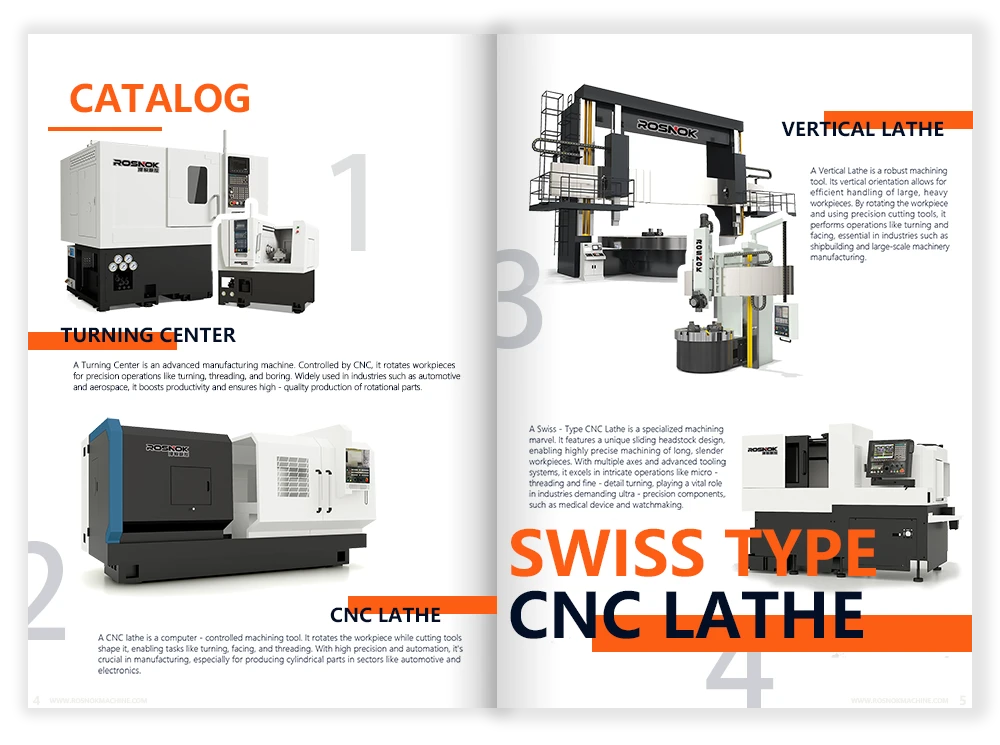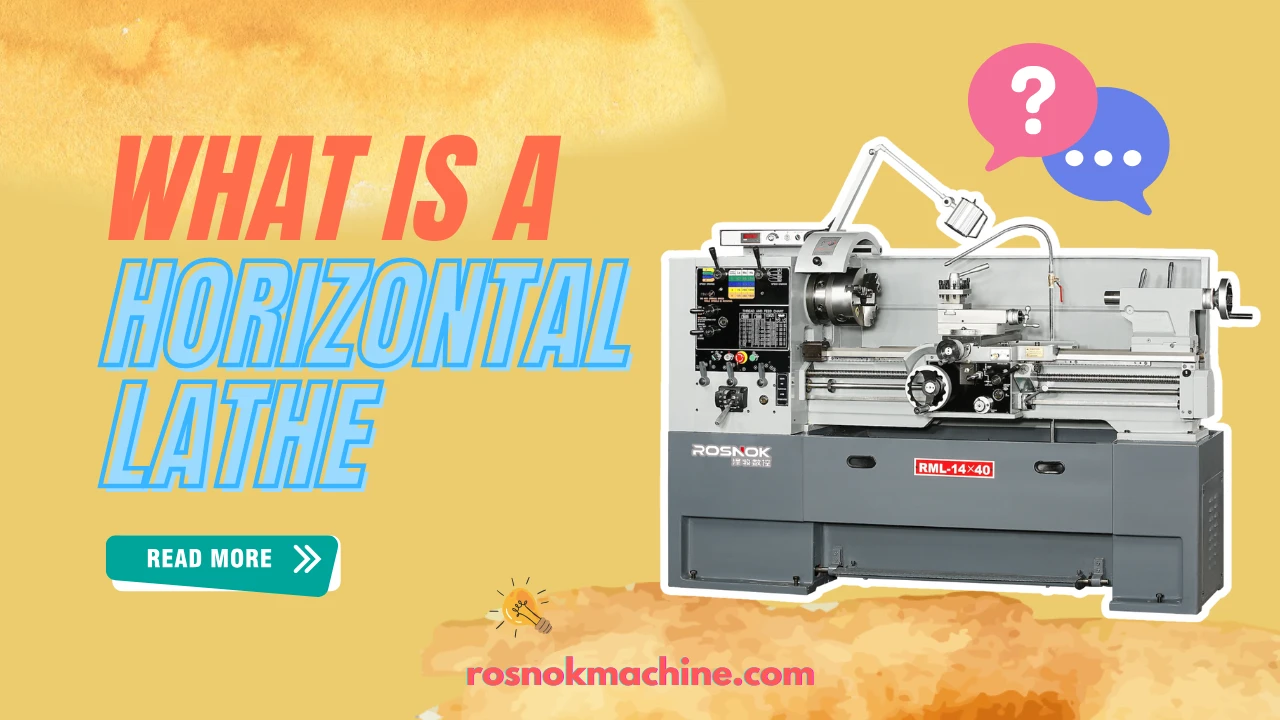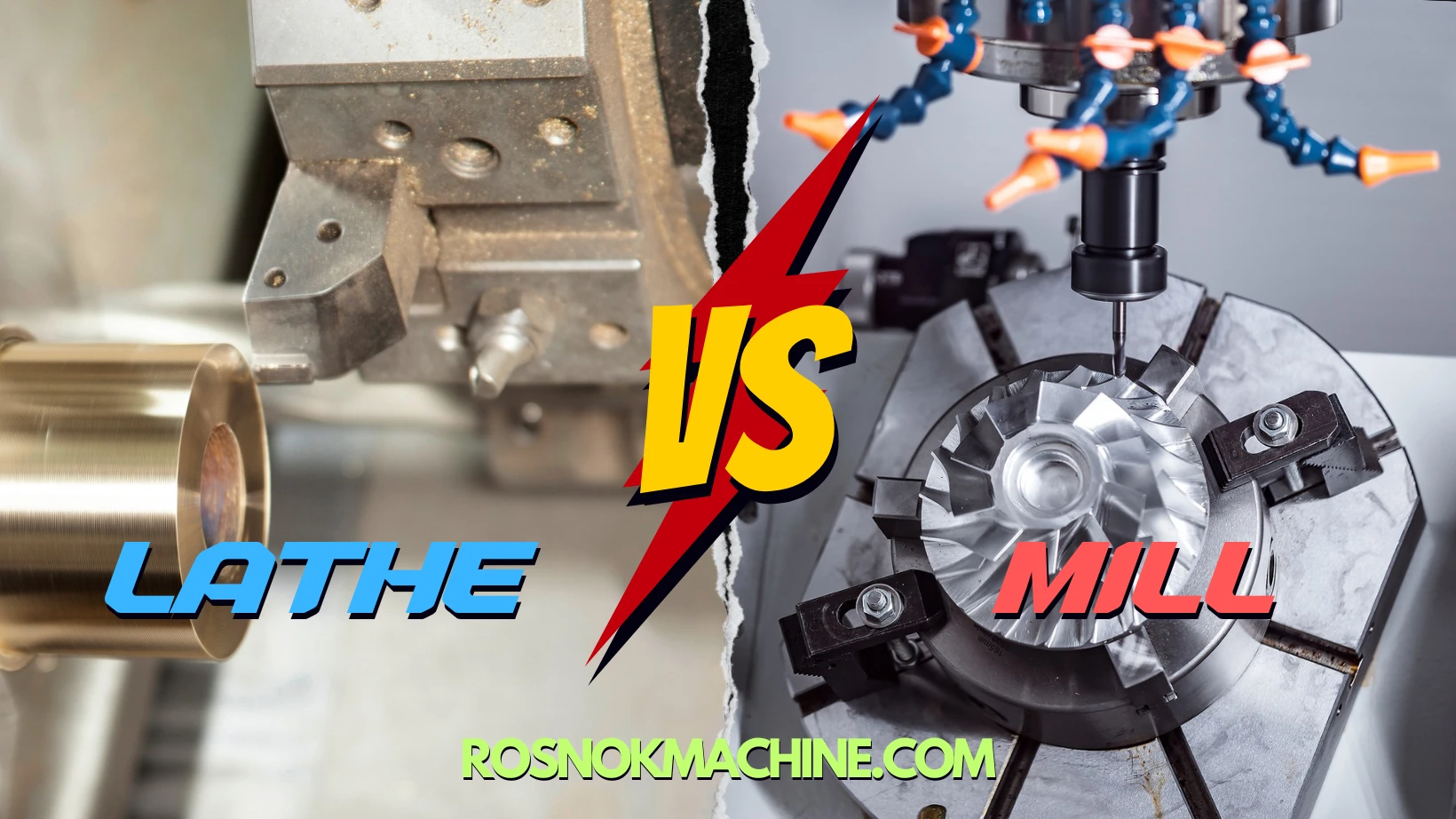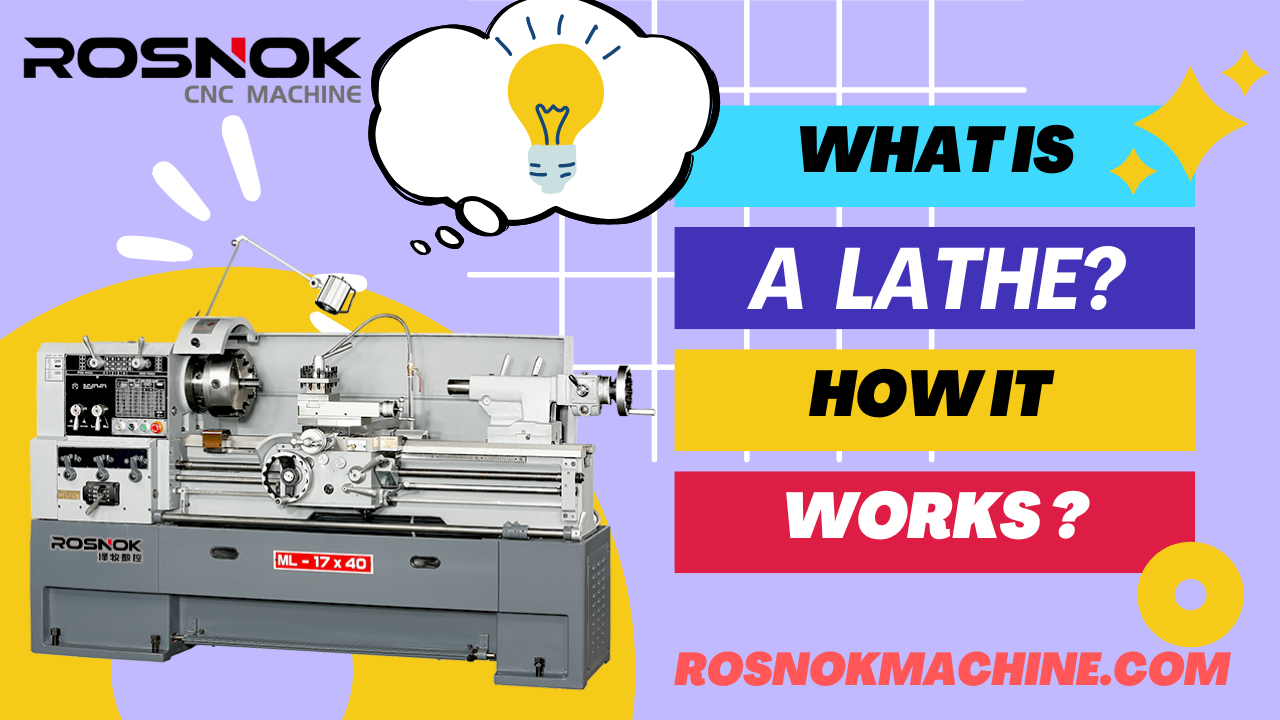Have you ever wondered what a horizontal lathe is and why it’s essential in modern CNC machining? Do you want to understand how it works, what parts it’s made of, and what kinds of metal components it creates? Curious how it compares to vertical lathes or where it’s used in real industries?
A horizontal lathe is a machine tool designed to rotate a workpiece around a horizontal spindle axis, while a stationary cutting tool shapes the material. Its bed is parallel to the ground, and the workpiece is clamped between the headstock and tailstock. This layout offers strong support for machining long, cylindrical components such as shafts, rods, and tubes with consistent precision. Horizontal lathes are widely used for symmetrical turning operations where stability and alignment are critical.
Continue reading to explore the structure, working principle, types, typical parts it machines, and key knowledge every beginner should know about horizontal lathes.
What Is a Horizontal Lathe?
Horizontal lathes are essential machines in modern metalworking, known for their ability to produce precise cylindrical parts. In this section, we’ll explore what they are and how they work.
Definition of a Horizontal Lathe
A horizontal lathe is a type of turning machine that rotates a workpiece around a horizontal spindle axis while a cutting tool removes material to shape it. This layout is specifically designed for machining symmetrical, cylindrical components such as shafts, rods, and tubes. Unlike vertical lathes, the spindle in a horizontal lathe is aligned parallel to the ground, which allows for stable, balanced rotation during turning operations.
The cutting tool is mounted on a carriage system and does not rotate itself. Instead, it moves precisely along defined paths—typically the Z-axis (parallel to the spindle) for lengthwise cutting and the X-axis (perpendicular to the spindle) for diameter control. This combination of rotating workpiece and linearly advancing tool allows material to be gradually removed in controlled layers. Horizontal lathes may be operated manually or through CNC systems, but their core function remains the same: shaping rotating parts with high precision and surface quality.
Basic Function and Layout
The core structure of a horizontal lathe is designed for simplicity, support, and stability. At the heart of the layout is a flat bed aligned parallel to the shop floor. This bed serves as the foundation for all other components, including the headstock, tailstock, and carriage. On one side, the headstock holds the spindle that rotates the workpiece; on the other, the tailstock provides end support, especially for longer parts. Between them, the workpiece is securely clamped, allowing precise machining without deflection. This layout offers two key advantages: strong mechanical rigidity and consistent axis alignment. As a result, horizontal lathes are ideal for applications requiring long, uniform components and are especially favored in industries like automotive, oil & gas, and general precision engineering.
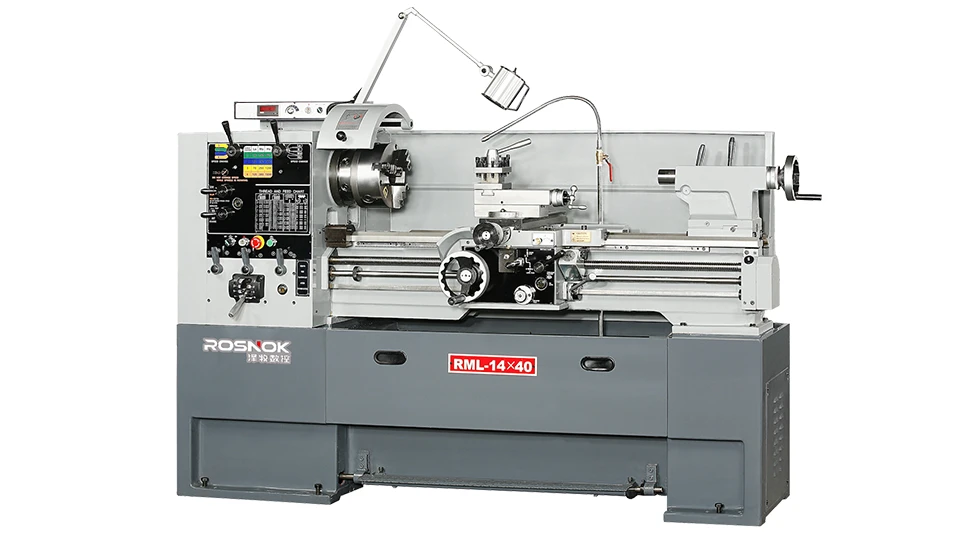
Key Structural Components of a Horizontal Lathe
Understanding the structure of a horizontal lathe is key to understanding how it operates. This section breaks down its core mechanical components and explains the role each one plays in the machining process.
Headstock and Spindle
The headstock is the powerhouse of the horizontal lathe. It houses the spindle, a motor-driven rotating shaft that delivers torque to the workpiece. The spindle spins the part at variable speeds, controlled manually or via CNC systems depending on the lathe type. Most headstocks are equipped with gears or belt systems that allow speed adjustment based on the workpiece material and operation requirements.
A key feature of the spindle is its through-hole (or bore), which allows long bars or shafts to extend through the spindle for supported turning. The spindle nose connects to a chuck, collet, or faceplate, offering flexibility for different part shapes and diameters. This setup supports a wide range of workholding requirements—crucial in industries that machine cylindrical components. In CNC models, spindle rotation is precisely regulated to maintain consistent cutting conditions under varying loads.
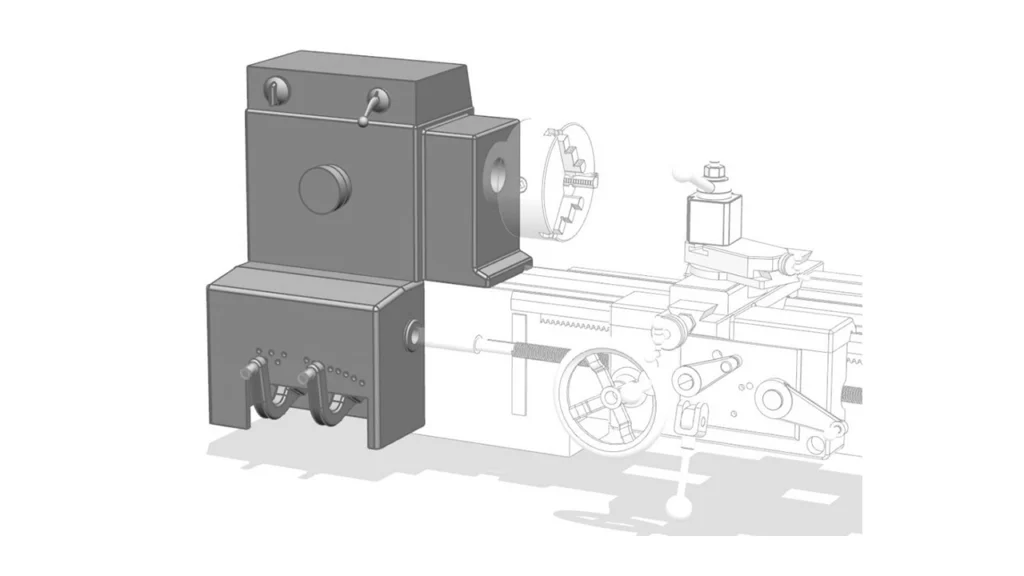
Tailstock and Quill
Mounted opposite the headstock, the tailstock provides axial support to the free end of the workpiece—especially critical when turning long, slender shafts that may deflect or vibrate. The tailstock slides along the lathe bed and can be adjusted to match the workpiece length.
At its core is the quill, a sleeve that contains a center point, often a live center, which can be extended or retracted. The quill locks into the workpiece’s end to keep it aligned and steady. Most tailstocks allow for micrometer-level adjustments, helping ensure that the centerlines of the spindle and tailstock remain perfectly aligned. This alignment is crucial for minimizing runout and achieving precision concentricity.
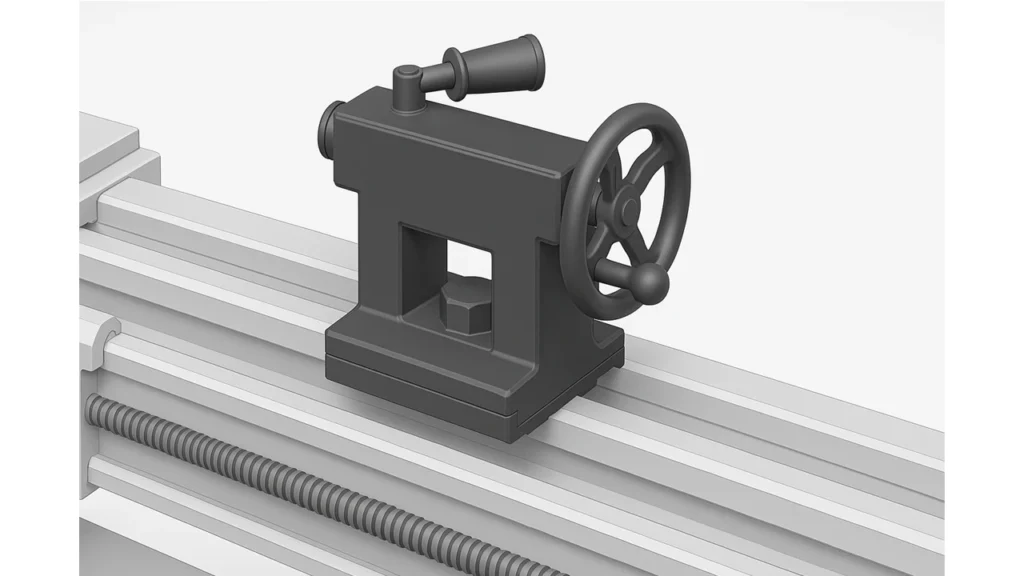
Bed and Guideways
The bed is the structural backbone of the lathe. It aligns and supports all major assemblies, including the carriage and tailstock. Beds are precision-machined from cast iron or similar materials to offer rigidity and vibration resistance—both essential for accuracy during cutting.
Guideways are machined tracks on the bed that ensure smooth, controlled carriage motion. Horizontal lathes typically feature flat guideways or V-shaped guideways. Flat guideways are common in heavy-duty applications due to their large contact area and load-bearing capacity. V-shaped types offer enhanced self-alignment, which helps maintain machining accuracy. The quality of these guideways affects both tool path consistency and long-term repeatability.
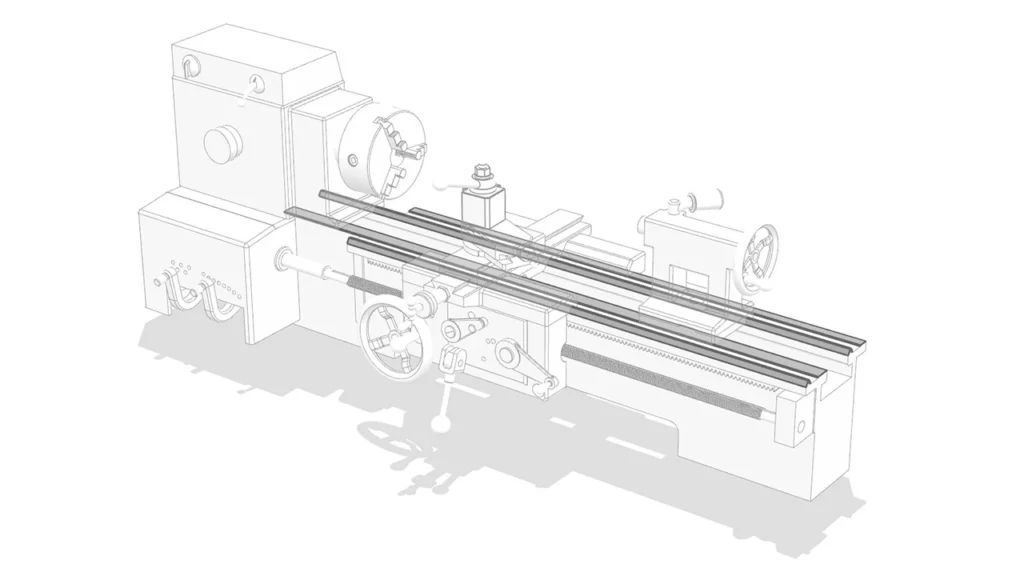
Carriage, Cross Slide, and Compound Rest
This assembly moves the cutting tool across the rotating workpiece. The carriage rides along the Z-axis (parallel to the spindle) and holds the cross slide, which moves along the X-axis (perpendicular to the spindle). On top of the cross slide is the compound rest, which can be angled for taper turning or fine adjustment.
This layered motion structure ensures precision movement in two dimensions. In manual lathes, motion is controlled by handwheels and lead screws; in CNC systems, movement is powered by ball screws and servo motors. The combined setup allows for controlled material removal with minimal chatter and vibration—critical for smooth surface finishes and tight tolerances.
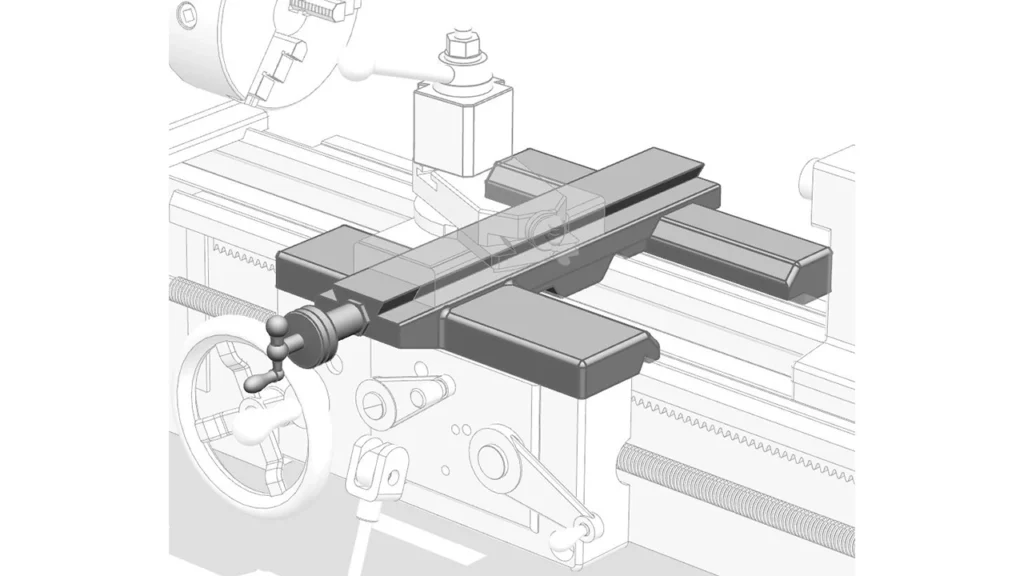
Tool Post and Chuck
The tool post is where cutting tools are clamped and positioned. Most manual horizontal lathes use a quick-change tool post, which allows for rapid switching between boring bars, threading tools, and other inserts. In CNC lathes, the post is replaced by a turret, which automatically rotates to index the correct tool during a machining program—significantly reducing cycle time and manual intervention.
The chuck, mounted on the spindle nose, secures the workpiece. The most common types are three-jaw chucks for round, symmetrical parts and four-jaw independent chucks for irregular or off-center workpieces. Chuck type influences both setup speed and machining accuracy. High-precision chucks with soft jaws can be custom-machined to fit each part perfectly. The quality of the chuck setup directly affects the runout, concentricity, and safety of the machining process—especially at higher spindle speeds.
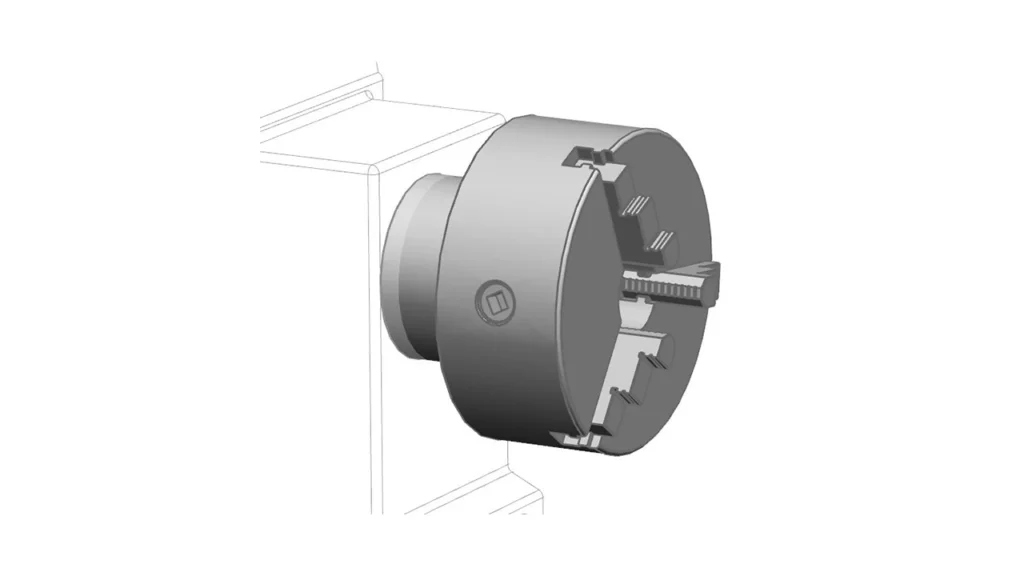
How Does a Horizontal Lathe Work?
Now that you know the parts, let’s see how they move and interact to shape metal into precise cylindrical forms.
Basic Machining Process
The horizontal lathe follows a simple but precise machining cycle. First, the raw material (usually a metal bar or shaft) is loaded into the chuck and clamped securely. Once the workpiece is fixed, the spindle begins rotating at a set speed, depending on the material and the operation type. As the workpiece spins, the cutting tool—mounted on the carriage—feeds into the material along pre-programmed or manually controlled paths.
Unlike milling or drilling, the key concept here is that the tool remains relatively stationary while the workpiece rotates. The cutting action occurs due to this relative motion between the tool and the spinning part. The tool gradually removes material in layers, shaping the surface into the desired diameter or profile. Once the operation is complete, the tool retracts, and the part is unloaded.
This cycle—load, clamp, rotate, feed, shape, retract—is repeated for every part and is the foundation of all turning operations on a horizontal lathe. The process can be performed manually or fully automated using CNC programming for consistent quality and minimal operator input.
Axes of Movement (X and Z)
A horizontal lathe operates primarily along two linear axes: X and Z. Understanding how these axes work is essential for visualizing how parts are shaped. The Z-axis runs parallel to the spindle and controls movement along the length of the workpiece. When the cutting tool moves in the Z direction, it machines the surface in an axial direction—essentially defining the part’s length and contours.
The X-axis, on the other hand, is perpendicular to the spindle and controls the tool’s movement toward or away from the workpiece center. Movements in this direction determine the part’s outer diameter. Together, these two axes allow the tool to remove material layer by layer and produce complex cylindrical shapes, grooves, tapers, and shoulders.
On CNC lathes, these axes are moved with precision using servo motors and ball screws, ensuring micron-level accuracy. For beginners, visualizing the axes as a crosshair—X for diameter, Z for length—is an easy way to understand toolpath planning on a horizontal lathe.
Material Removal and Surface Finish
Material removal on a lathe is typically divided into two stages: roughing and finishing. During roughing, the cutting tool removes large amounts of material quickly using higher feed rates and deeper cuts. This stage shapes the part close to its final dimensions. Finishing follows, using finer cuts and slower feed rates to achieve the final size, tighter tolerances, and better surface smoothness.
Several factors influence the surface finish of a turned part. These include tool sharpness, spindle speed, feed rate, and depth of cut. For instance, a dull tool or overly aggressive feed can cause tool marks or chatter, reducing surface quality. Conversely, using a sharp insert with optimal cutting parameters ensures a smoother finish.
Coolant or cutting fluid is often used to control heat buildup and flush away chips. This not only improves the tool life but also enhances the dimensional accuracy of the part. For applications like bearing surfaces or precision threads, achieving a high-quality surface finish is essential—often requiring specific tool geometries and multi-pass finishing strategies.How Does a Horizontal Lathe Work?
Now that you know the parts, let’s see how they move and interact to shape metal into precise cylindrical forms.
Basic Machining Process
The horizontal lathe follows a simple but precise machining cycle. First, the raw material (usually a metal bar or shaft) is loaded into the chuck and clamped securely. Once the workpiece is fixed, the spindle begins rotating at a set speed, depending on the material and the operation type. As the workpiece spins, the cutting tool—mounted on the carriage—feeds into the material along pre-programmed or manually controlled paths.
Unlike milling or drilling, the key concept here is that the tool remains relatively stationary while the workpiece rotates. The cutting action occurs due to this relative motion between the tool and the spinning part. The tool gradually removes material in layers, shaping the surface into the desired diameter or profile. Once the operation is complete, the tool retracts, and the part is unloaded.
This cycle—load, clamp, rotate, feed, shape, retract—is repeated for every part and is the foundation of all turning operations on a horizontal lathe. The process can be performed manually or fully automated using CNC programming for consistent quality and minimal operator input.
Axes of Movement (X and Z)
A horizontal lathe operates primarily along two linear axes: X and Z. Understanding how these axes work is essential for visualizing how parts are shaped. The Z-axis runs parallel to the spindle and controls movement along the length of the workpiece. When the cutting tool moves in the Z direction, it machines the surface in an axial direction—essentially defining the part’s length and contours.
The X-axis, on the other hand, is perpendicular to the spindle and controls the tool’s movement toward or away from the workpiece center. Movements in this direction determine the part’s outer diameter. Together, these two axes allow the tool to remove material layer by layer and produce complex cylindrical shapes, grooves, tapers, and shoulders.
On CNC lathes, these axes are moved with precision using servo motors and ball screws, ensuring micron-level accuracy. For beginners, visualizing the axes as a crosshair—X for diameter, Z for length—is an easy way to understand toolpath planning on a horizontal lathe.
Material Removal and Surface Finish
Material removal on a lathe is typically divided into two stages: roughing and finishing. During roughing, the cutting tool removes large amounts of material quickly using higher feed rates and deeper cuts. This stage shapes the part close to its final dimensions. Finishing follows, using finer cuts and slower feed rates to achieve the final size, tighter tolerances, and better surface smoothness.
Several factors influence the surface finish of a turned part. These include tool sharpness, spindle speed, feed rate, and depth of cut. For instance, a dull tool or overly aggressive feed can cause tool marks or chatter, reducing surface quality. Conversely, using a sharp insert with optimal cutting parameters ensures a smoother finish.
Coolant or cutting fluid is often used to control heat buildup and flush away chips. This not only improves the tool life but also enhances the dimensional accuracy of the part. For applications like bearing surfaces or precision threads, achieving a high-quality surface finish is essential—often requiring specific tool geometries and multi-pass finishing strategies.
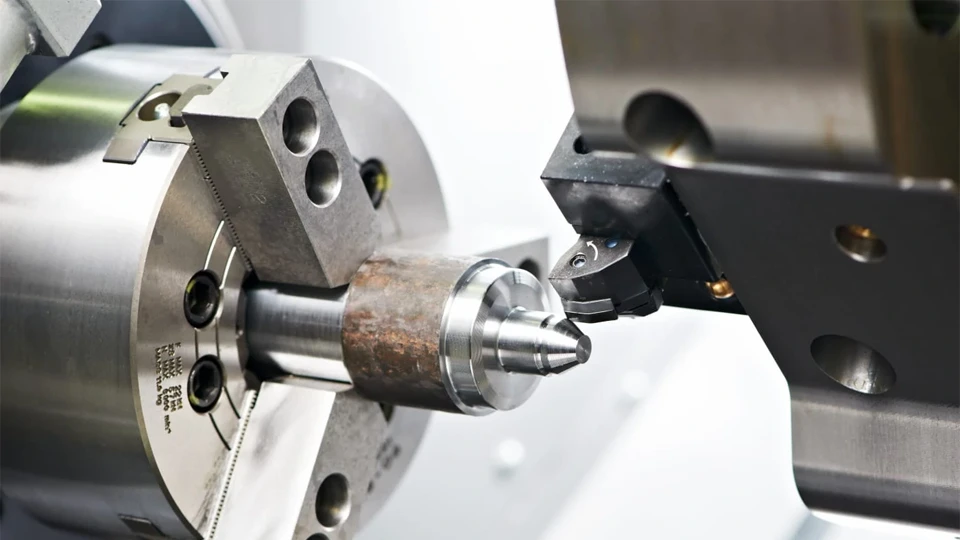
What Parts Can Be Made with a Horizontal Lathe?
Explore the types of components that are typically produced with horizontal lathes—from basic shafts to complex threaded parts.
Typical Cylindrical Parts
Horizontal lathes are primarily used for machining rotationally symmetrical parts. The most common category is cylindrical shafts—solid or hollow. These include straight rods, stepped axles, rollers, and motor shafts, all of which require high concentricity and stable dimensional accuracy. Industries like automotive and industrial automation rely on these parts for engines, gearboxes, and transmission systems.
Hollow components such as metal tubes and sleeves are also widely produced on horizontal lathes. These parts are often found in piping systems, bearing assemblies, and hydraulic mechanisms. The through-spindle bore of the lathe enables long pipes or rods to be machined in sections while maintaining tight tolerances over the entire length.
Threaded rods and studs are another category well-suited for this machine type. Horizontal lathes are capable of forming both external and internal threads—metric or imperial—with high precision, especially when paired with CNC threading cycles. These threaded components are essential in construction, oil & gas, and mechanical assembly systems, where repeatability and fit quality matter most.
Due to their stable structure and two-point support design, horizontal lathes are particularly effective at turning these components without chatter or deflection, even under heavy cutting loads. Whether used for roughing large diameter stock or finishing fine-tolerance pins, the machine’s configuration ensures accurate and efficient results.
Specialized Components
Beyond standard shafts and rods, horizontal lathes can also produce more advanced or custom-designed components. Tapered shafts, which require a gradual reduction in diameter along their length, are a common example. By adjusting the tool’s movement along both X and Z axes simultaneously, operators can achieve consistent tapers for parts like drive shafts and connectors.
Stepped shafts—components with varying diameters and shoulder transitions—are another specialty of the horizontal lathe. These parts are often used in machinery that requires precise mounting points for bearings, gears, or couplings. The machine’s rigid layout ensures each transition is clean and within tolerance.
Flange-type parts are also easily machined. These often combine round central shafts with wider, flat discs for mounting or sealing applications. Turning the flange faces, outer diameters, and bolt circle grooves requires consistent tool access and rigidity, which horizontal lathes provide thanks to their open cutting path and adjustable carriage system.
Another key category is pipe threads and tubing components, especially in sectors like oilfield drilling and plumbing. A horizontal pipe thread lathe, designed with an extra-large spindle bore and reinforced bed, can handle long, thick-walled pipes and produce tapered threads, straight threads, or API-standard connections with precision. These machines are built to accommodate the length and torque requirements of heavy pipework.
Together, these parts showcase the wide versatility of the horizontal lathe—not just in geometry, but also in the industries it serves. From manufacturing aerospace connectors to producing custom hydraulic fittings, the machine’s ability to deliver precise rotational components is unmatched.
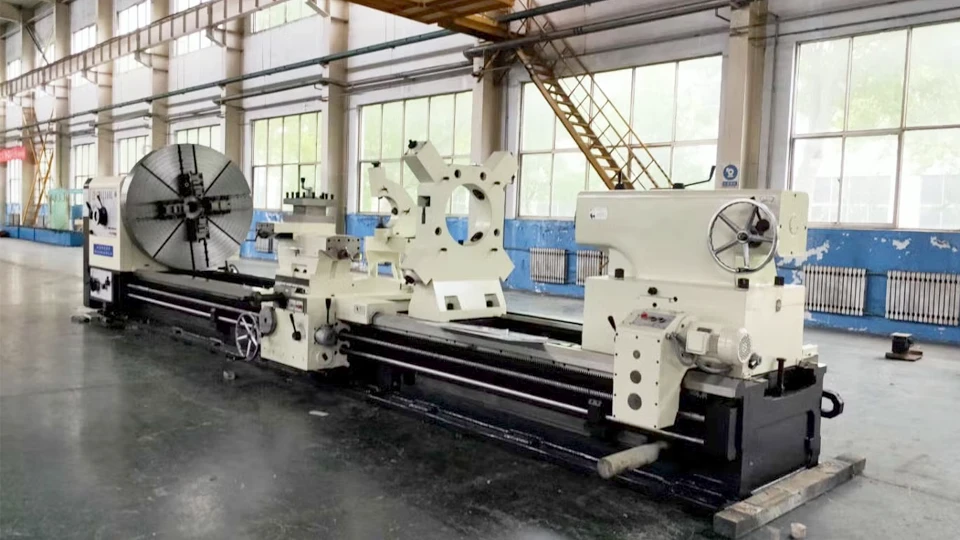
Types of Horizontal Lathes
Not all horizontal lathes are built the same. Learn which types are right for different tasks and how they vary in function and performance.
Manual Horizontal Lathe
Manual horizontal lathes are operated by hand and rely on the machinist’s skill to perform all machining steps. These machines feature mechanical handwheels for feeding the tool along the X and Z axes, and speed or feed changes are adjusted via gearbox levers. Because of their simplicity, they are commonly used in maintenance workshops, small repair jobs, prototyping, and training environments. Manual lathes are ideal for tasks that require flexibility, such as one-off parts or operations that need real-time human control. While they lack automation, they offer strong tactile feedback and are excellent for teaching basic machining concepts.
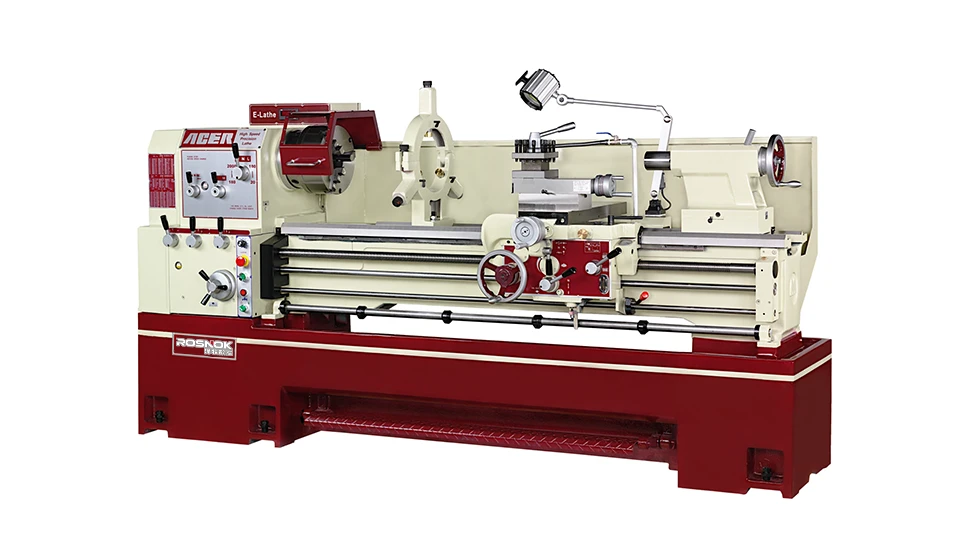
CNC Horizontal Lathe
A CNC horizontal lathe uses a computer numerical control system to automate the machining process. The machine interprets digital G-code instructions to move the cutting tool, control spindle speeds, and execute complex sequences like threading, grooving, or profiling. CNC horizontal lathes support automatic tool changers, servo-driven axes, and even live tooling in more advanced models. This enables high repeatability and efficiency when producing medium to large production runs. These machines are ideal for parts with complex geometries, tight tolerances, or multi-step operations that require consistent quality. Because all movements are controlled electronically, setup and cycle times are significantly reduced compared to manual versions.
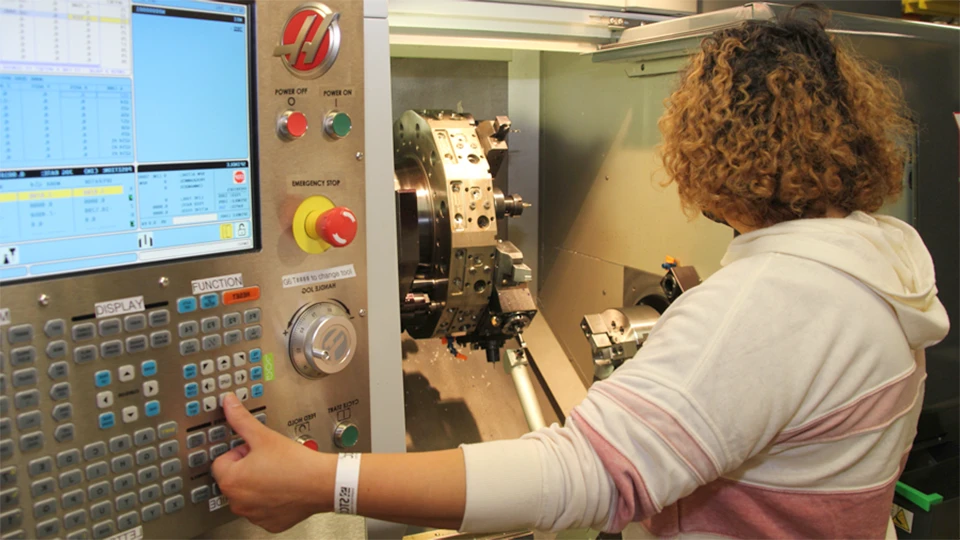
Pipe Thread Lathe
Designed specifically for industries like oil and gas, the pipe thread lathe is a horizontal lathe with a much larger spindle bore. This allows it to accommodate long, thick-walled pipes for threading both ends without repositioning. The chuck systems are engineered to grip irregularly shaped or heavy tubular materials securely, often using hydraulic or pneumatic clamping. These machines specialize in cutting API, BSP, or metric threads onto pipes used in drilling, casing, and high-pressure transport systems. Their beds are reinforced to support long workpieces, and the tool post may be optimized for threading inserts, ensuring clean, accurate thread profiles under heavy load.
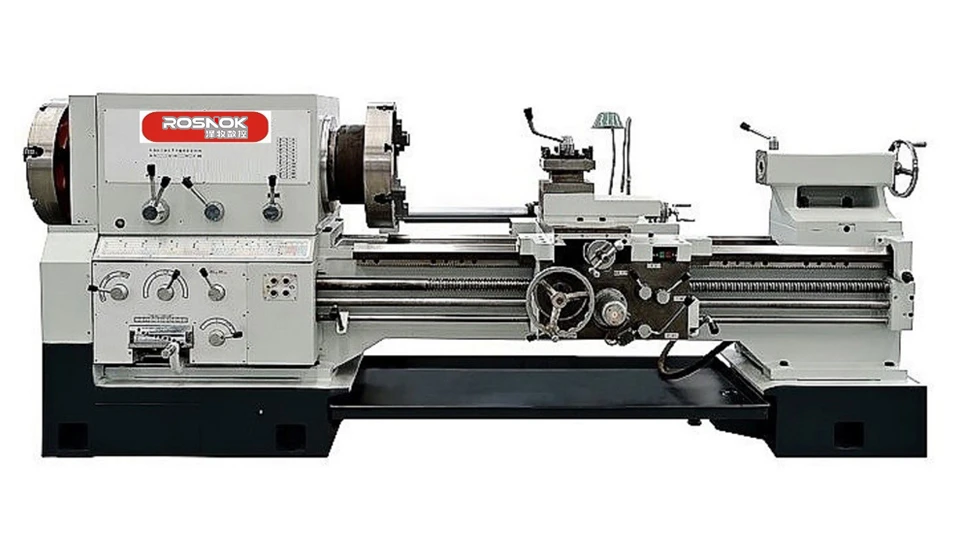
Slant-Bed vs. Flat-Bed
Horizontal lathes come in two main bed configurations: flat-bed and slant-bed. A flat-bed lathe has its bed parallel to the ground and is traditionally preferred for longer workpieces that need steady support. This layout offers excellent rigidity and is easier to maintain, making it suitable for general-purpose machining.
In contrast, a slant-bed lathe features a tilted bed, usually at a 30° or 45° angle. This design improves chip evacuation, allows better visibility of the cutting zone, and facilitates gravity-fed coolant flow. Slant-bed machines are often chosen for high-speed production environments because they combine structural strength with improved ergonomics and automatic chip management.
Choosing between the two depends on your machining priorities: if your goal is large, heavy parts with long turning lengths, a flat-bed lathe offers maximum support. For faster cycle times and better automation compatibility, a slant-bed design is often the better choice.
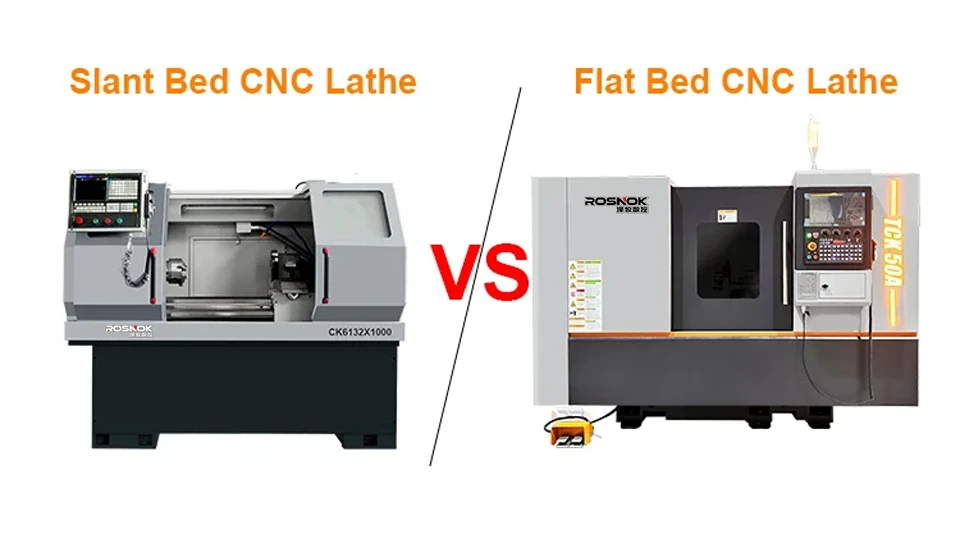
Horizontal Lathe Applications in the Real World
Horizontal lathes are widely used across modern manufacturing sectors, offering both flexibility and reliability when machining cylindrical metal components. Their ability to handle long parts with tight tolerances makes them essential in industries that demand repeatable precision, material consistency, and scalable output.
Automotive Manufacturing
In the automotive industry, horizontal lathes are used to machine critical rotating components such as crankshafts, camshafts, drive shafts, axle hubs, and gear blanks. These parts require exceptional concentricity, dimensional accuracy, and smooth surface finishes to ensure optimal engine performance and safety. Horizontal turning enables rigid clamping and precise longitudinal machining, which is vital when producing components subject to high-speed rotation and thermal stress. Many factories favor CNC horizontal lathes for this application due to their capacity for batch production and tight process control.
Aerospace Components
Aerospace applications often involve machining parts from high-performance alloys like titanium, Inconel, and hardened stainless steel. Horizontal lathes play a key role in producing hydraulic rods, landing gear shafts, actuator cylinders, and connection pins. These parts demand micron-level tolerances and are often slender or long, making them prone to deflection. The dual-point support system of horizontal lathes—via headstock and tailstock—minimizes vibration, ensuring geometric accuracy and consistent wall thickness. Advanced CNC versions often integrate live tooling and automated probing to meet the aerospace industry’s stringent quality standards.
Oil & Gas and Pipe Machining
In the oil and gas sector, horizontal lathes—especially pipe thread lathes—are essential for turning drill pipes, casings, couplings, and wellhead fittings. These parts often require standardized thread forms like API buttress or tapered threads, which must be cut with absolute accuracy. Pipe lathes are designed with large spindle bores and powerful chucking systems to accommodate long and heavy tubular workpieces. They also allow for internal and external threading, taper boring, and chamfering—all crucial for pressure-sealing integrity in high-risk environments.
General Precision Engineering
Outside of industry-specific uses, horizontal lathes support a wide range of general engineering tasks such as producing one-off prototypes, small-batch custom components, jigs, and test pieces. Their versatility makes them suitable for metal fabrication workshops, research labs, and toolrooms. Whether turning bushings, flanges, pulleys, or fixture components, horizontal lathes offer the adaptability and ease of setup required for diverse project needs. Their compatibility with various materials—steel, aluminum, brass, plastics—also extends their application in general-purpose machining and experimental development.
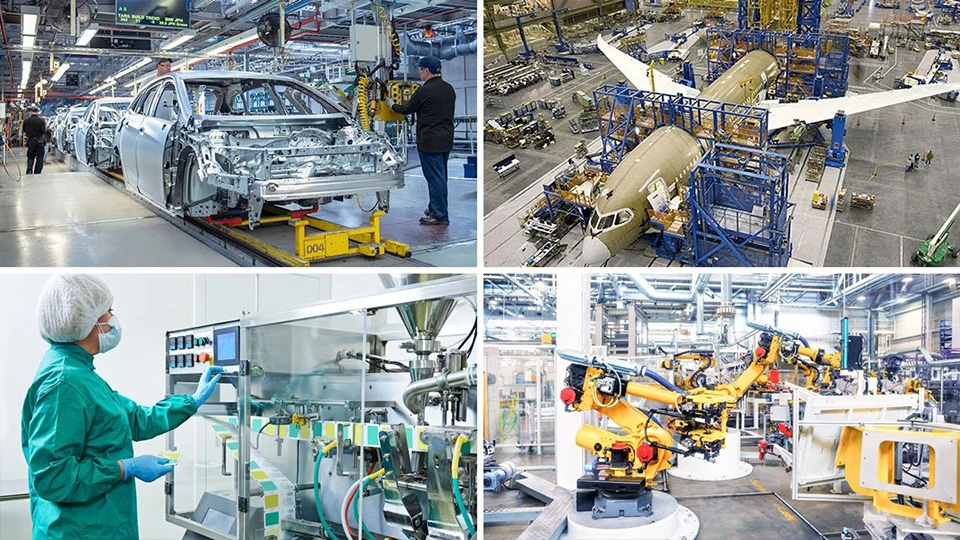
Why Choose a Horizontal Lathe?
Horizontal lathes have stood the test of time in manufacturing for good reason. Their design offers practical advantages in accuracy, reliability, and flexibility—making them a top choice for machining cylindrical components in a wide range of industries.
Structural Advantages
One of the most significant reasons to choose a horizontal lathe is its structural stability. The workpiece is clamped between the headstock and tailstock along a horizontal axis, allowing both ends to be supported during rotation. This dual-point support minimizes deflection, especially when machining long shafts or tubes. The lathe bed, typically made from cast iron or high-strength alloys, provides excellent rigidity and vibration damping, which are crucial for maintaining dimensional accuracy at higher cutting speeds. The linear guideways, usually hardened and ground, ensure the cutting tool stays on a consistent path even under heavy loads. These structural traits allow horizontal lathes to deliver smoother surface finishes, longer tool life, and tighter tolerances—key factors in any high-precision turning operation.
Versatility and Adaptability
Horizontal lathes are not limited to simple turning operations. They are highly adaptable platforms capable of handling multiple machining processes, including facing, threading, boring, taper turning, grooving, and parting. Many models support modular configurations, where tool posts, tailstocks, and chucks can be quickly swapped or adjusted to suit different workpiece dimensions. In CNC horizontal lathes, automatic tool changers and live tooling options further expand the machine’s capabilities, allowing for operations like drilling and milling in a single setup. Whether you’re working with small precision parts or large industrial shafts, the ability to customize fixtures and tooling setups gives horizontal lathes a clear edge in flexibility.
Ease of Operation and Maintenance
Ease of use is another compelling reason why manufacturers—especially those just starting with turning operations—often opt for horizontal lathes. Manual models feature intuitive handwheel controls and analog readouts, which are ideal for training environments or low-volume tasks. CNC horizontal lathes come equipped with user-friendly interfaces, such as G-code-based controllers or conversational programming systems, reducing the learning curve for new operators. Maintenance is generally straightforward: lubrication points are centralized, covers are easy to remove, and diagnostics systems help identify issues before they escalate. Additionally, replacement parts for common wear items like belts, chucks, and bearings are widely available, which reduces downtime and lowers the total cost of ownership.
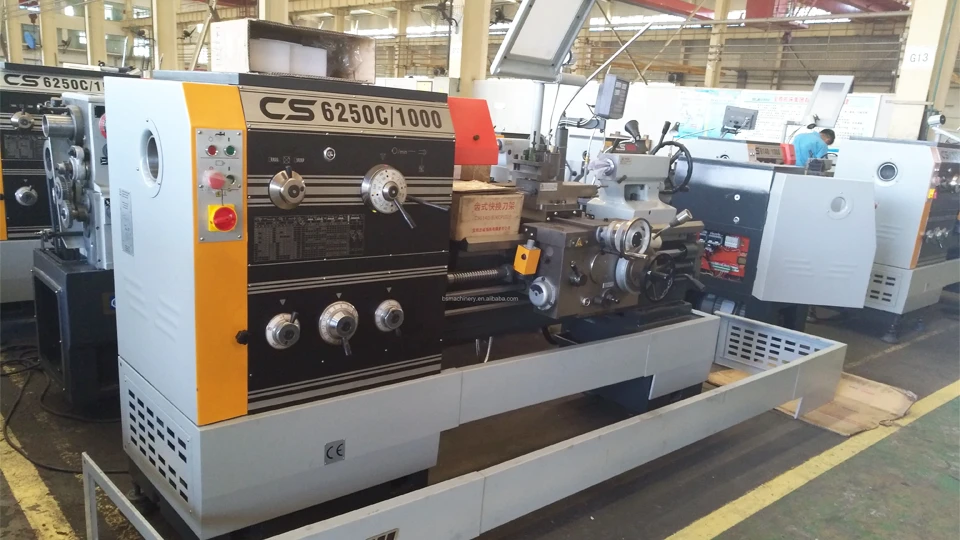
Common Beginner Questions About Horizontal Lathes
Common questions arise when beginners encounter a horizontal lathe for the first time—about its capabilities, limitations, and learning curve. In this section, we’ll address those fundamental doubts clearly and practically, helping you build confidence in understanding and operating the machine.
Can It Cut Non-Round Parts?
Horizontal lathes are specifically designed for machining rotationally symmetrical parts—components that are circular when viewed from the end. This means they are ideal for turning shafts, tubes, and discs, but not suitable for non-round or prismatic parts. Since the workpiece must rotate on a central axis, any geometry that lacks radial symmetry cannot be properly clamped or cut. For irregular shapes, flat surfaces, or complex 3D contours, other machines such as vertical milling machines or CNC machining centers are required. Understanding this limitation is essential when selecting the right machine tool for your manufacturing task.
What Materials Can Be Turned?
A horizontal lathe can process a wide variety of materials commonly used in manufacturing. These include carbon steel, stainless steel, aluminum, brass, bronze, cast iron, titanium alloys, and even engineering plastics like nylon or POM. However, each material poses its own challenges. For instance, stainless steel requires lower cutting speeds and higher rigidity, while aluminum allows for faster turning but may produce long chips if not managed properly. Plastics, though soft, can deform under heat, so coolant control is critical. Choosing the correct insert, speed, and feed rate for each material ensures both tool longevity and surface quality.
How Long of a Workpiece Can It Handle?
The maximum workpiece length a horizontal lathe can accommodate depends on three key factors: the center-to-center distance (distance between the headstock and tailstock), the tailstock stroke, and the chuck’s clamping depth. Most industrial lathes will clearly specify this maximum length in their technical data sheets. For example, a lathe with a 1500mm center distance can handle a shaft just under that length, depending on chuck and tailstock configurations. When choosing a lathe for your shop, always consider not only length but also rigidity, as longer workpieces are more prone to deflection during machining.
Is It Easy to Learn?
Compared to more complex multi-axis CNC equipment, a horizontal lathe—especially a manual one—is relatively beginner-friendly. Its operating logic is straightforward: secure the workpiece, set the tool, define the feed direction, and begin cutting. Many vocational schools use manual lathes to teach fundamentals of metal cutting, axis movement, and workpiece setup. CNC models introduce automation and programming, but modern interfaces often include conversational modes, G-code assistants, and simulation previews to lower the learning curve. With proper training and a focus on safety, new operators can become proficient within a short time.
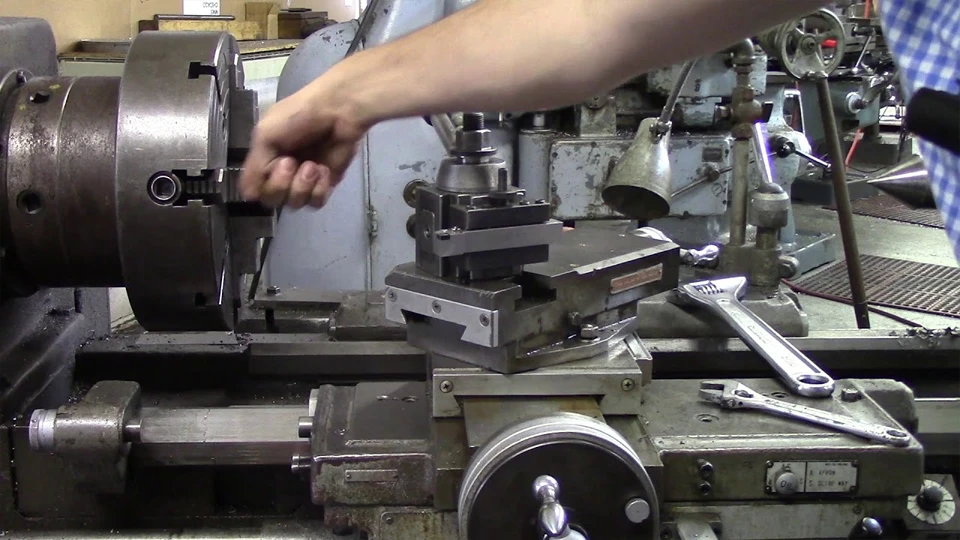
Conclusion
Horizontal lathes are fundamental to modern machining, especially when it comes to turning cylindrical components with accuracy and consistency. Throughout this article, we’ve explored what a horizontal lathe is, how its flat-bed structure and spindle orientation support stable workholding, and how the machine operates along the X and Z axes for precise material removal. You’ve learned the typical parts that can be produced, such as shafts, pipes, and threads, and how to distinguish between manual, CNC, and specialized models. We also outlined clear reasons to choose a horizontal lathe—its structural rigidity, operational flexibility, and user-friendly maintenance—all of which make it a valuable investment across industries.
For manufacturers seeking reliable and high-performance horizontal lathes, it’s important to work with experienced suppliers who understand the real-world demands of machining. At Rosnok, we specialize in producing industrial-grade CNC machines—ranging from horizontal lathes to pipe-thread lathes and Swiss-type turning centers. Our machines are engineered for precision, durability, and adaptability, with international certifications and strong after-sales support that customers trust. Whether you’re a distributor, a production engineer, or exploring machining for the first time, partnering with an expert manufacturer can make all the difference.
